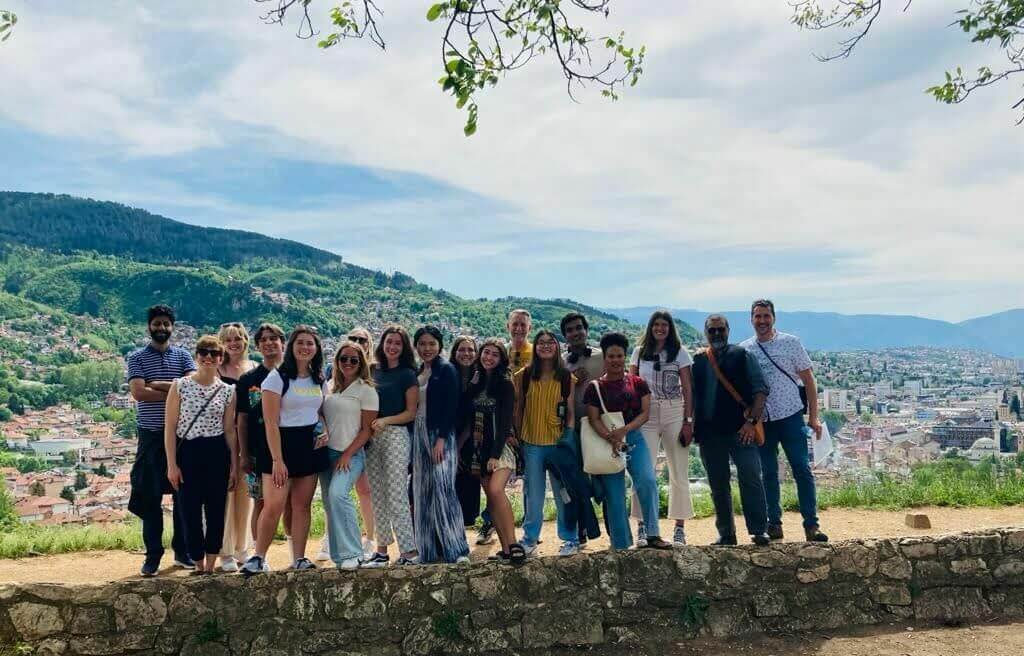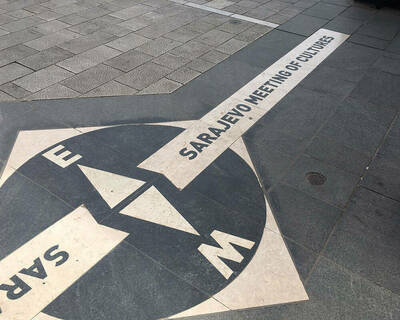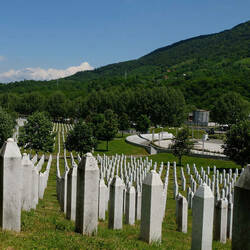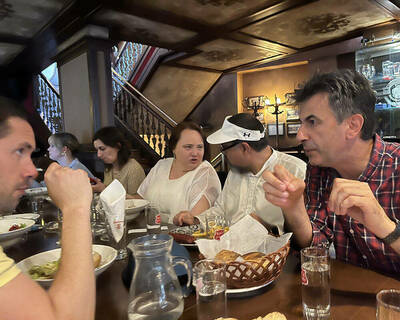
During our May student trip to Sarajevo, Amra, one of our discussion facilitators, laughed, cigarette dangling from her lips, as she likened the city to a femme fatale—alluring, but with a dark side. It was, we soon learned, an apt description for a lovely and complicated city, one that has been simultaneously strengthened and scarred by its history.

Sarajevo, the capital of Bosnia and Herzegovina, is a place where one can trace the influence of multiple empires, the place where east meets west. A spot in the old city marks the “meeting of cultures”: A gaze to one side reveals an old Ottoman-style city; an about-face places one in the midst of Austro-Hungarian architecture. Our hotel was mere steps away from this spot, offering us a tangible sense of place and history—one that would repeatedly challenge us.
Our group, which included fourteen students from Notre Dame was drawn to Sarajevo to study “Religion, Identity, and Peace and the Periphery of Europe.” The trip was possible thanks to generous financial support from the Nanovic Institute for European Studies and an important on-the-ground partnership with Peace Catalyst International (PCI). The Kroc Institute for International Peace Studies and the Ansari Institute for Global Engagement with Religion provided additional support.
We visited Sarajevo—and Bosnia and Herzegovina more broadly—for several reasons. First, it has witnessed terrible violence in recent history, and the scars are visible in the landscape and endure in living memory. Also, it is far from the “centers” of Europe where students might typically travel—places such as London, Rome, and Dublin. Finally, it confounds pre-conceptions of Islam in Europe. Often, when one imagines Muslims there, the images that come to mind are African or Asian migrants. But Bosnian Muslims, in contrast, are ethnically European: southern Slavs who are caucasian or white, just like their Croat and Serb neighbors.
Navigating competing narratives
Historian Max Bergholz, in his attempt to study unspeakable acts of violence perpetrated by ordinary citizens, provides three helpful methodological orientations: 1) the need to transcend disciplinary provincialism; 2) the importance of establishing a sense of place; and 3) the challenge of practicing historical empathy. Our trip fully embraced all three. Our partner organization, PCI, arranged visits to historic sites, preparatory readings and documentaries, and onsite meetings with religious leaders, scholars, and peacemakers.
Bryan Carey, our PCI partner in Sarajevo, emphasized the need to go deeper into the past, beyond the turmoil of the 1990s or World War II, to adequately appreciate competing historical narratives. His concise, three-page primer was our starting point. It mapped for us the main ethnic groups—Serbs (Orthodox Christians), Bosniaks (Muslims), and Croats (Catholics)—and their histories of conflict. Bryan’s expertise and experience accompanied us throughout the trip. He was joined by his family for many of our activities. The Careys, fluent in Bosnian and American languages and cultures, became a joyous and reassuring feature of our stay.
The challenge of viewing the three narratives side-by-side quickly became apparent. Is truth relative to one’s narrative and experiences? Do the competing narratives simply cancel each other out? Are all grievances equal? Who is the biggest victim? How does one mediate between contentious stories of loss and trauma? These questions haunted us throughout our encounters, lending credence to the imperative for both “truth” and “reconciliation” in post-conflict societies, not merely one without the other.

In a post-truth world with alternative facts, “truth and reconciliation” require credible mediation by neutral parties—strong international institutions. The various sides cannot be expected to work it out on their own. Our visit to the Srebrenica memorial site commemorating genocide against Bosniaks brought home this reality. When students retreated to the onsite museum portraying photos of human tragedy in vivid detail, a Serb wedding party drove by in celebration, flags waving, horns blazing. Tensions remain. As we strolled through the somber site in silence—centered by a courtyard for ritual prayer surrounded by gravestones nearly as far as the eye could see— we began to develop a sense of place and of history.

The following day we were joined by ten Bosnian students—Bosniaks and Serbs—who remained with us for the remainder of the week. Our Notre Dame group was already quite diverse, comprising of students of various ethnicities and national origins: Chinese, Vietnamese, Indian, Pakistani, Columbian, Nicaraguan, Trinidadian and Tobagonian, and, U.S. “It’s as if I’m addressing the United Nations,” noted one of our facilitators, Srđan Puhalo, a “ruthless social critic of Bosnian politics and nationalism” with a Chomsky-esque aura.
It was through these interactions between the participants that conceptual breakthroughs began to occur. Eventually, the tables were turned; questions began to flow in both directions. “What is it like in the United States? Why is society there so polarized, so militant? How do tensions there resemble what we have in Bosnia, and how are they different? How do you facilitate dialogue across your differences? Who among you is a Republican and who is a Democrat?” These kinds of questions helped to nurture historical empathy.
“We will always find a reason to fight,” noted Vahidin Omanović, a professional trainer in nonviolent communication and conflict resolution. In the mid-twentieth century, some leaders of what eventually became Pakistan had argued that Hindus and Muslims simply couldn’t live together. They belonged to incompatible religious families: one Dharmic, the other Abrahamic. The history books call it “the two-nation theory.” A couple of decades later, Muslims in West Pakistan (now Pakistan) and East Pakistan (now Bangladesh) discovered they couldn’t live with each other either.

In Bosnia, Serbs, Croats, and Bosniaks—who all look the same, speak the same language, and adhere to the same Abrahamic family of faiths—are at each other’s throats. In the United States, the fault lines are completely different, where Catholics can go against Catholics in an ideological battle between Left and Right. “I have been observing American society,” Omanović said. “The situation has become dangerous.”
Omanović and his colleague, Mevludin Rahmanović operate a Center for Peacebuilding (CIM), a small town in northwestern Bosnia on the bank of the Sana River. They impressed upon the students to work on peacebuilding at home in the United States. “Look what became of us. You can’t let that happen to you. You must find ways to talk to each other across ideological divides.” Professor Ahmet Alibašić, in our visit to the faculty of Islamic studies of the University of Sarajevo, cautioned: “In 1990 I served in the Yugoslav army. I could never have imagined what would happen to us in just five years.”
A journey of inner transformation
On my last day in Bosnia and Herzegovina, after students had safely departed, I met a hardliner who reminded me of why we had embarked upon this trip. He questioned why we were there, what our hidden agenda might be, and chided us as being part of an industry of peacebuilding tourists.
“Groups like you come and go, but nothing changes,” he said. “This is a matter of life and death for us. It’s about my children’s survival.”
I listened, doing my best to see things from his point of view.
“The terms we use matter,” he continued, testing my knowledge of the issues with a trick question about nationality vs. ethnicity. “Is the tennis player Novak Đoković, a Serb, or Serbian?”

“Both,” I responded, cautiously. His tone was aggressive, inquisitorial. Femme fatale had revealed her dark side, and I saw again how the city’s inhabitants still carry the weight of history on their shoulders and still feel the deep pain of the violence and atrocities committed during the Bosnian War in the 1990s. There were no easy answers on the path forward.
As we talked more, I explained that we did not set out to swoop in and change the world. We were not here to tell them how to feel about the conflict or to impose our own solutions. Far from it. Our program goals were far more modest: We were ultimately there to change ourselves, a waystation on the way to helping to change the world. A Qur’anic passage captures the relationship between the two: “God does not change a people until they change what is within themselves.” (Qur’an, 13:11)
Our ambition for the trip came not in grandiose visions of external change, but in thoughtful engagement that challenged each of us to reflect and embark upon a journey of self-discovery and transformation.

In Learning to Flourish, philosopher Daniel R. DeNicola tells us that self-actualization, understanding the world, and engagement with the world are three of the five core paradigms of a liberal education. The “end” of such an education embraces both self and society. And according to historian Mark van Doren, one of the hallmarks of a liberal education is when the learner begins to see everything as connected. Or, as historian Max Bergholz says, one must transcend disciplinary provincialism.
Our many conversations were never constrained by the artificial boundaries that academic disciplines sometimes impose on us as thinkers. Drawing fluidly from many classes and disciplines—political science, psychology, peace studies, sociology, religion, anthropology, history, theology—students explored the legacy of old and new conflicts. We considered how narratives can unite or divide us, imagined peacebuilding in different contexts, and pondered how to take a cross-disciplinary approach to promoting human dignity that embraces complexity, which we at the Keough School of Global Affairs call “integral human development.” Our window into that journey of holistic learning was the great land, history, religions, and peoples of Bosnia and Herzegovina.